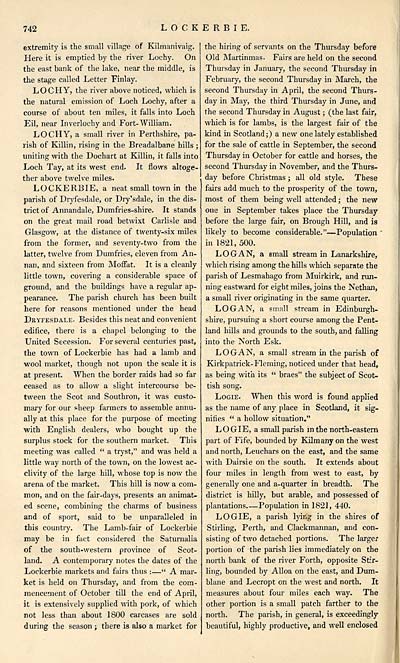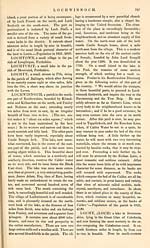Gazetteer of Scotland > Volume 2
(258) Page 742
Download files
Complete book:
Individual page:
Thumbnail gallery: Grid view | List view

742
LOCKERBIE.
extremity is the small village of Kilmanivaig.
Here it is emptied by the river Lochy. On
the east bank of the lake, near the middle, is
the stage called Letter Finlay.
LOCHY, the river above noticed, which is
the natural emission of Loch Lochy, after a
course of about ten miles, it falls into Loch
Eil, near Inverlochy and Fort- William.
LOCHY, a small river in Perthshire, pa-
rish of Killin, rising in the Breadalbane hills ;
uniting with the Dochart at Killin, it falls into
Loch Tay, at its west end. It flows altoge-
ther above twelve miles.
LOCKERBIE, a neat small town in the
parish of Dryfesdale, or Dry'sdale, in the dis-
trict of Annandale, Dumfries-shire. It stands
on the great mail road betwixt Carlisle and
Glasgow, at the distance of ttventy-six miles
from the former, and seventy-two from the
latter, twelve from Dumfries, eleven from An-
nan, and sixteen from Moffat. It is a cleanly
little town, covering a considerable space of
ground, and the buildings have a regular ap-
pearance. The parish church has been built
here for reasons mentioned under the head
Dryfesdale- Besides this neat and convenient
edifice, there is a chapel belonging to the
United Secession. For several centuries past,
the town of Lockerbie has had a lamb and
wool market, though not upon the scale it is
at present. When the border raids had so far
ceased as to allow a slight intercourse be-
tween the Scot and Southron, it was custo-
mary for our sheep farmers to assemble annu-
ally at this place for the purpose of meeting
with English dealers, who bought up the
surplus stock for the southern market. This
meeting was called " a tryst," and was held a
little way north of the town, on the lowest ac-
clivity of the large hill, whose top is now the
arena of the market. This hill is now a com-
mon, and on the fair-days, presents an animat-
ed scene, combining the charms of business
and of sport, said to be unparalleled in
this country. The Lamb-fair of Lockerbie
may be in fact considered the Saturnalia
of the south-western province of Scot-
land. A contemporary notes the dates of the
Lockerbie markets and fairs thus : — " A mar-
ket is held on Thursday, and from the com-
mencement of October till the end of April,
it is extensively supplied with pork, of which
not less than about 1800 carcases are sold
during the season ; there is also a market for
the hiring of servants on the Thursday before
Old Martinmas. Fairs are held on the second
Thursday in January, the second Thursday in
February, the second Thursday in March, the
second Thursday in April, the second Thurs-
day in May, the third Thursday in June, and
the second Thursday in August ; (the last fair,
which is for lambs, is the largest fair of the
kind in Scotland;) a new one lately established
for the sale of cattle in September, the second
Thursday in October for cattle and horses, the
second Thursday in November, and the Thurs-
day before Christmas ; all old style. These
fairs add much to the prosperity of the town,
most of them being well attended ; the new
one in September takes place the Thursday
before the large fair, on Brough Hill, and is
likely to become considerable." — Population "
in 1821, 500.
LOGAN, a small stream in Lanarkshire,
which rising among the hills which separate the
parish of Lesmahago from Muirkirk, and run-
ning eastward for eight miles, joins the Nethan,
a small river originating in the same quarter.
LOGAN, a small stream in Edinburgh-
shire, pursuing a short course among the Pent-
land hills and grounds to the south, and falling
into the North Esk.
LOGAN, a small stream in the parish of
Kirkpatrick- Fleming, noticed under that head,
as being with its " braes" the subject of Scot-
tish song.
Logie. When this word is found applied
as the name of any place in Scotland, it sig-
nifies " a hollow situation."
LOGIE, a small parish in the north-eastern
part of Fife, bounded by Kilmanyon the west
and north, Leuchars on the east, and the same
with Dairsie on the south. It extends about
four miles in length from west to east, by
generally one and a-quarter in breadth. The
district is hiUy, but arable, and possessed of
plantations Population in 1821, 440.
LOGIE, a parish lying in the shires of
Stirling, Perth, and Clackmannan, and con-
sisting of two detached portions. The larger
portion of the parish lies immediately on the
north bank of the river Forth, opposite Stir-
ling, bounded by Alloa on the east, and Dum-
blane and Lecropt on the west and north. It
measures about four miles each way. The
other portion is a small patch farther to the
north. The parish, in general, is exceedingly
beautiful, highly productive, and well enclosed
LOCKERBIE.
extremity is the small village of Kilmanivaig.
Here it is emptied by the river Lochy. On
the east bank of the lake, near the middle, is
the stage called Letter Finlay.
LOCHY, the river above noticed, which is
the natural emission of Loch Lochy, after a
course of about ten miles, it falls into Loch
Eil, near Inverlochy and Fort- William.
LOCHY, a small river in Perthshire, pa-
rish of Killin, rising in the Breadalbane hills ;
uniting with the Dochart at Killin, it falls into
Loch Tay, at its west end. It flows altoge-
ther above twelve miles.
LOCKERBIE, a neat small town in the
parish of Dryfesdale, or Dry'sdale, in the dis-
trict of Annandale, Dumfries-shire. It stands
on the great mail road betwixt Carlisle and
Glasgow, at the distance of ttventy-six miles
from the former, and seventy-two from the
latter, twelve from Dumfries, eleven from An-
nan, and sixteen from Moffat. It is a cleanly
little town, covering a considerable space of
ground, and the buildings have a regular ap-
pearance. The parish church has been built
here for reasons mentioned under the head
Dryfesdale- Besides this neat and convenient
edifice, there is a chapel belonging to the
United Secession. For several centuries past,
the town of Lockerbie has had a lamb and
wool market, though not upon the scale it is
at present. When the border raids had so far
ceased as to allow a slight intercourse be-
tween the Scot and Southron, it was custo-
mary for our sheep farmers to assemble annu-
ally at this place for the purpose of meeting
with English dealers, who bought up the
surplus stock for the southern market. This
meeting was called " a tryst," and was held a
little way north of the town, on the lowest ac-
clivity of the large hill, whose top is now the
arena of the market. This hill is now a com-
mon, and on the fair-days, presents an animat-
ed scene, combining the charms of business
and of sport, said to be unparalleled in
this country. The Lamb-fair of Lockerbie
may be in fact considered the Saturnalia
of the south-western province of Scot-
land. A contemporary notes the dates of the
Lockerbie markets and fairs thus : — " A mar-
ket is held on Thursday, and from the com-
mencement of October till the end of April,
it is extensively supplied with pork, of which
not less than about 1800 carcases are sold
during the season ; there is also a market for
the hiring of servants on the Thursday before
Old Martinmas. Fairs are held on the second
Thursday in January, the second Thursday in
February, the second Thursday in March, the
second Thursday in April, the second Thurs-
day in May, the third Thursday in June, and
the second Thursday in August ; (the last fair,
which is for lambs, is the largest fair of the
kind in Scotland;) a new one lately established
for the sale of cattle in September, the second
Thursday in October for cattle and horses, the
second Thursday in November, and the Thurs-
day before Christmas ; all old style. These
fairs add much to the prosperity of the town,
most of them being well attended ; the new
one in September takes place the Thursday
before the large fair, on Brough Hill, and is
likely to become considerable." — Population "
in 1821, 500.
LOGAN, a small stream in Lanarkshire,
which rising among the hills which separate the
parish of Lesmahago from Muirkirk, and run-
ning eastward for eight miles, joins the Nethan,
a small river originating in the same quarter.
LOGAN, a small stream in Edinburgh-
shire, pursuing a short course among the Pent-
land hills and grounds to the south, and falling
into the North Esk.
LOGAN, a small stream in the parish of
Kirkpatrick- Fleming, noticed under that head,
as being with its " braes" the subject of Scot-
tish song.
Logie. When this word is found applied
as the name of any place in Scotland, it sig-
nifies " a hollow situation."
LOGIE, a small parish in the north-eastern
part of Fife, bounded by Kilmanyon the west
and north, Leuchars on the east, and the same
with Dairsie on the south. It extends about
four miles in length from west to east, by
generally one and a-quarter in breadth. The
district is hiUy, but arable, and possessed of
plantations Population in 1821, 440.
LOGIE, a parish lying in the shires of
Stirling, Perth, and Clackmannan, and con-
sisting of two detached portions. The larger
portion of the parish lies immediately on the
north bank of the river Forth, opposite Stir-
ling, bounded by Alloa on the east, and Dum-
blane and Lecropt on the west and north. It
measures about four miles each way. The
other portion is a small patch farther to the
north. The parish, in general, is exceedingly
beautiful, highly productive, and well enclosed
Set display mode to: Large image | Transcription
Images and transcriptions on this page, including medium image downloads, may be used under the Creative Commons Attribution 4.0 International Licence unless otherwise stated. ![]()
| Gazetteers of Scotland, 1803-1901 > Gazetteer of Scotland > Volume 2 > (258) Page 742 |
|---|
| Permanent URL | https://digital.nls.uk/97433918 |
|---|
| Description | Volume II: Glenbanchor to Zetland. |
|---|---|
| Attribution and copyright: |
|
| Description | By Robert Chambers and William Chambers. Glasgow: Blackie & Son, 1838. 2 volumes. |
|---|---|
| Shelfmark | NF.1461.g.7 |
| Additional NLS resources: | |

